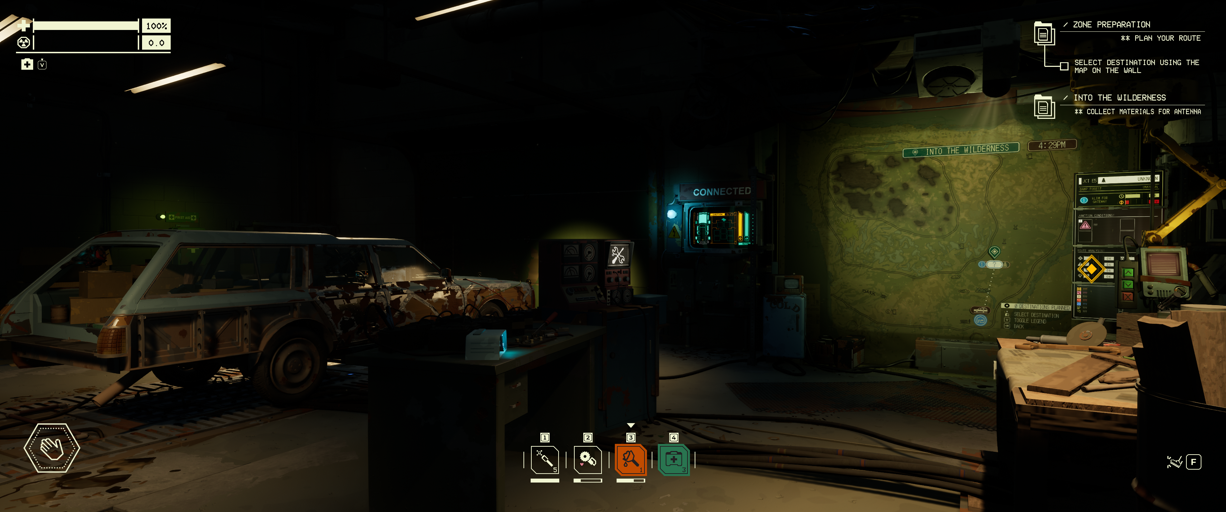The Pacific Drive Steam Next Fest Demo hooked me in and I preordered the full game. I couldn’t wait to play more after the demo ended. Fast forward to now and I’ve spent 13 plus hours, while only completing a handful of the story missions. I’m happy to report I still can’t wait to play more, so now let me gush.
The High Tech Pacific Drive Story
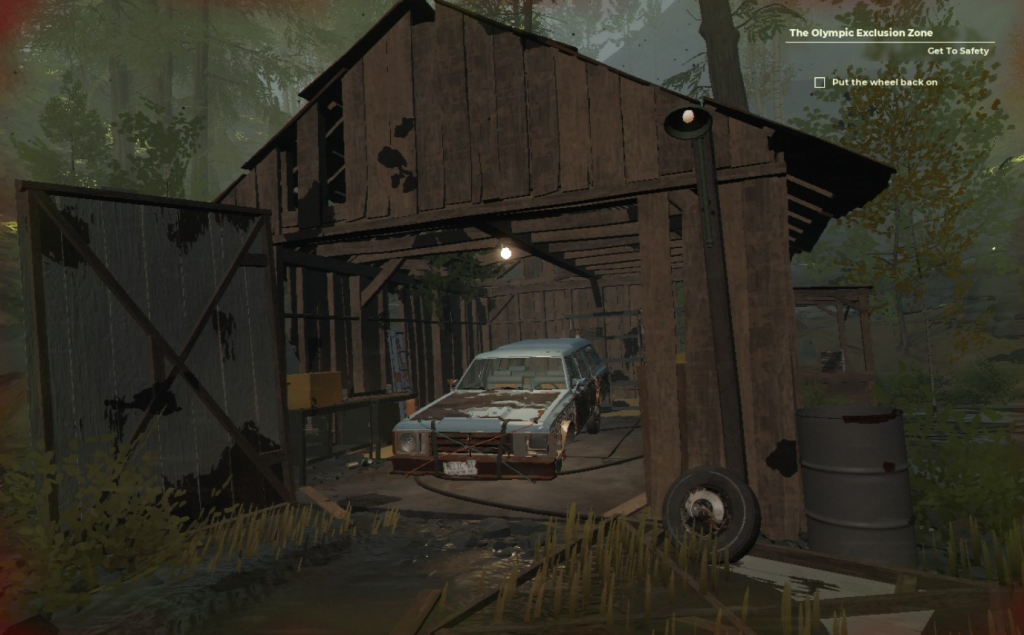
The background of Pacific Drive revolves around the Olympic Exclusion Zone. LIM technology carried out truly impressive experiments that went horribly wrong. Things went so bad that the government constructed a giant wall around the zone. No one knows what goes on inside anymore.
Fast forward to the game start and the player character is unlucky to get sucked through the wall by an anomaly. I saw it all before in my demo, so I flew through the tutorial to get to where I left off when the demo ended.
From there I carried out quests for Oppy, Francis and Tobias, all former LIM scientists, at least I think they are. The whole mission is to research the anomalies to build new technology in order to escape beyond the walls. The majority of the story carries out via radio chatter, audio logs and logs.
I’m definitely looking forward to learning more about what really happened and how to get out. Where the real magic of the game is though, is the trip. The trip truly is greater than the destination.
The Pacific Drive Station Wagon is the Star
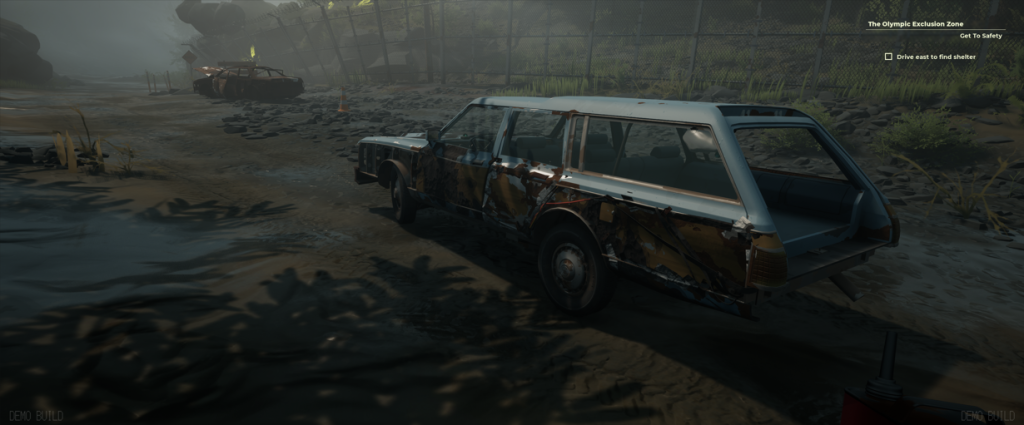
Drive is in the name, so the car is important. There’s only one car and it’s the ugly Clark Griswold style Station Wagon from Christmas Vacation. The way this game almost forces such love for that car though, it works.
Right from the start, I had to put a spare tire on. As I mentioned in my demo, there’s a bit of a process to get going even with everything installed. I’d open the door to get in, turn the key, shift it into drive and then go. Headlights and windshield wipers are there to turn on when needed also.
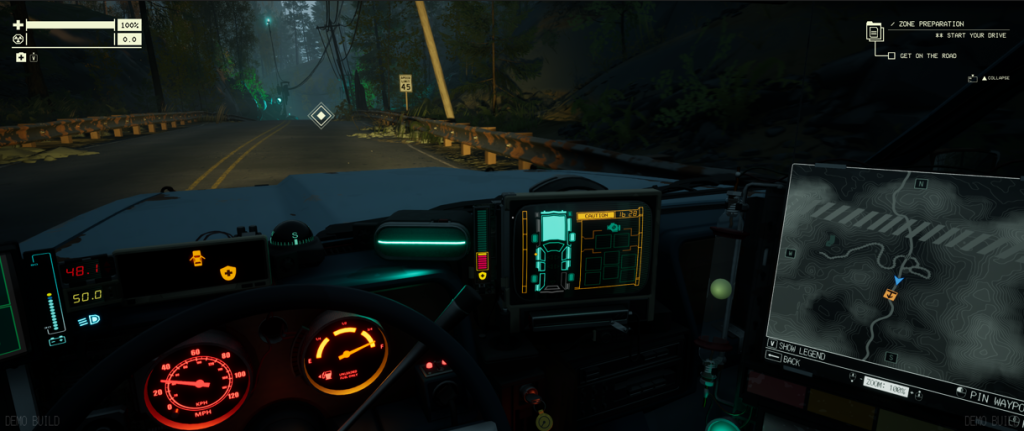
The dashboard in Pacific Drive models the various indicator lights for the car systems very well. There’s a gauge for the battery since all the fancy equipment drains it over time. There’s even a car status display to show parts that are damages. Honestly there’s stuff packed in there that I even forget what it does.
Longer and harder trips lead to running low on gas, so the game introduced the ability to syphon gas early on. What I didn’t think about until about 10 hours in was fill up the car’s tank, then fill up the gas can for some backup without having to find a vehicle or barrel to syphon from.
Making the Car the Mobile Home Base
Soon after my first trip to the garage, I installed storage boxes in the trunk and a crafting table. It’s definitely nice to have that mobile mini-home base functionality in case I forget something or lose it. The Arc Device I soon installed on the passenger seat is one of the most important parts.
It’s the most essential piece of tech in the car when navigating the zone. It serves as map, weather/anomaly warning service, Arc energy storage and portal generator. If you’ve seen the trailers, this is the device that activates the giant pillar of light for extraction from the zone.
Things go even deeper as there’s a car abilities interface to assign unlocked tech to. The game gifted me the parking brake, which I could bind to any of the 4 keys on the abilities menu. I chose the Space bar as other games often map e-brake to that.
Keep Moving in Pacific Drive
All those care features are decent functionality to start, but the parking break situation is starting to wear thin. I forgot to put it in park and the car rolled away a couple times. It’s funny for a few times to run after my car, except when I was in a hurry deeper into the game.
The good news is when I do truly tire of that, there’s upgraded tech to auto park/auto go. I’ll definitely spring for that soon. Only downside is it will require me to spend resources on a seat storage rack first.
There’s also a whole Quirks system where encountering anomalies can leave some undesired effects on the car. The first one I finally solved on my car was my passenger door did not want to stay closed. It took me a bit before I could figure out what caused it and fix it. I’ll get to how I did that in the garage section.
The Pacific Drive Garage is Home Base
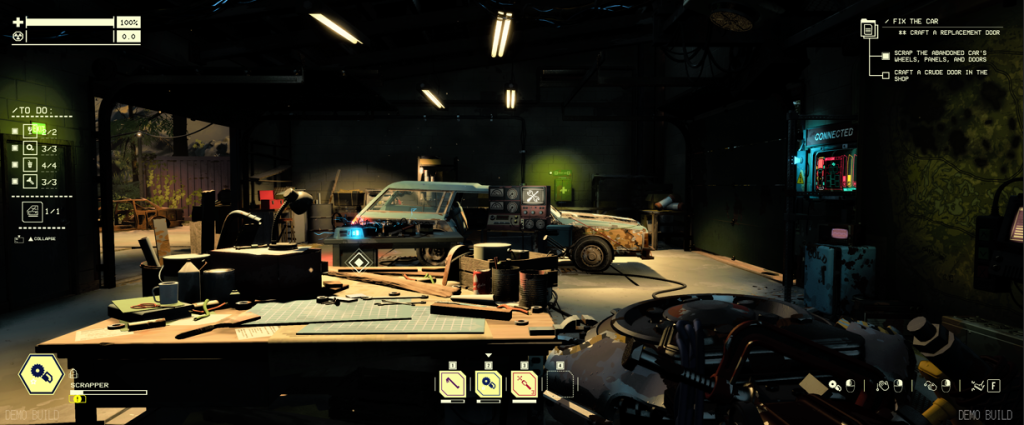
The garage is maybe the best home base in any game I’ve played. The minor complaint I have is not being able to close both garage doors when it’s storming. It would add to the immersion as I crank the jukebox and work on my car. Other than that minor gripe, I love the Pacific Drive garage.
Early on, there’s scanning equipment to acquire and diagnose problems with parts of the car. It’s fun to craft puncture kits to fix cracked panels, windows and flat tires. Special Repair Putty is the go to in order to repair most damage. That Sci-Fi goo just splats on parts, spreads itself out and repairs the damage.
Sometimes I’d run out of ingredients to craft the Repair Putty, so I’d simply remove damaged car parts and craft new ones. Adding and removing the panels, doors, bumpers, tires, etc. is very satisfying. Sometimes I’d find better parts that I’d quickly swap out to increase my armor any other bonuses.
The Garage will Provide
It’s hard to gather all the materials I want on runs out to the zone. Lucky for me, there’s a Friendly Dumpster outside of the garage. The helpful trash receptacle spits out a few useful items and some necessary ones.
If I was running low on repair putty, sometimes it would spit that out. Other times it would spit out replacement parts instead. Some essential parts are useful to get me back out in the zone, but the game is careful to avoid abuse. The essential equipment provided cannot be repaired or recycled.
There’s also a junked car and some computer parts outside of the garage that regenerate after each trip. I used that to help craft some better tires and new panels, quite a few times. I also found that there’s a giant high tech vacuum in the Fabricator room to flip a switch and suck up the mess of parts I might leave on the floor.
It was a nice quick way to gather everything up without wasting some of the durability of my handheld material vacuum. The handheld vacuum, by the way, is a great way to quickly suck up parts dropped when using the grinder to scravenge.
Preparing for the Next Journey to the Zone
The garage is so great that I look forward to returning it. I enjoy repairing my equipment, stocking up on supplies and seeing what I can upgrade. I love having the jukebox cranked with music that enhances the mood of my garage time.
It’s definitely not the typical music I listen to in my real car, but that’s all the more impressive how well it just fits. With music cranked, I’ll typically transfer items I scavenged from the trunk to the garage storage, then check the Fabrication Machine to see what upgrades I can unlock.
From there I’d craft any new, exciting equipment and install it on my car. I do this first to maximize the materials I acquired before I spend some on fixes. Accessing the car status board on the wall gives me the checklist of what’s missing or damages.
It also includes reminders to pack essential equipment like a Battery Jumper, Fuel Can, Flares, etc.. As a Project Manager during the day, I love checking things off of task lists. Getting things done is satisfying for me. I also get a kick out of using the fuel pump to fill up the car, since my real life car is electric.
Pacific Drive provides a proper Dr. Frankenstein moment when it’s time to flip the switch to juice up the battery. Those electrical effects are great, plus it’s a nice touch that the lights dim and radio cuts out for second. After all my repairs and upgrades, I flip that switch in a true “It’s Alive!” type moment.
Honestly who ever worked on that aspect, bravo, because it’s so satisfying.
Fixing my Car Quirks
As I mentioned in the car section, my Pacific Drive car developed a habit of opening the passenger door by itself. The garage has a diagnostic station where I can fix it, once I guess what causes it. There’s 8 guesses that resets every time you travel to the zone.
I first had to sit in my car with the passenger door closed and try to reproduce the problem. It soon dawned on me that the passenger door opened every time I shifted from Drive to Park. Maybe a bit too happy with myself, I chose the cause on the diagnostic machine, then what the result is and success.
The computer listed the fix as using a mechanic kit, so I grabbed one and fixed it directly at the computer. Later on, I noticed my headlights would flicker intermittently. Even when I upgraded to better ones, the problem remained.
It took me a lot longer to figure that one out, but I figured out they’d flicker every time I’d steer left or right. The diagnostics also listed like 5 other error codes for my car. I could spend a couple hours upgrading the diagnostics machine and tinkering with the car.
It really is a great puzzle system that adds additional depth to driving and the garage. Although, it might be a bane for those that have OCD for that type of thing.
Driving into the Zone

All that time in the garage is in service to venture out into Pacific Drive’s Olympic Exclusion Zone. I’d head over to the route planner in the garage, view possible routes and any info I have about them, then choose. That was the moment of truth to see how well I prepared.
I’d drive out of the garage and down the road before the load screen started. Every trip is technically a one way trip. When I’d drive through the entry gate for each junction area, a giant machine blocked the path behind me.
It’s weird to not have a full open world, but the way the game handles extractions makes it all work. The zone mixes up location for each run, hence the loading screen. Each junction map is large enough to satisfy, so it’s almost like a hub type open world.
The Second Time was Not Good Luck
Back when I played the demo, I was easily able to get through the tutorial mission in the zone. In the full game though, things took a bad turn. I looted a bunch of materials and then grabbed the Arc orb from one of the stability anchors. That orb would feed my Arc Device and allow me to escape back to the garage.
This time around though, breaking the stability anchor led to instability very quickly. The ground shook and pieces of earth rose from the ground. It flipped my car completely over and I mini-panicked after thinking of all the loot sitting in the trunk.
Lucky for me, the LIM technology in the Arc Device includes an emergency teleport system. All I needed was enough space for a car in front of me and it teleported it to that space, right side up. I quickly jumped in and sped off.
I almost forgot the most important step though. The whole purpose of grabbing that first orb was to activate the Arc Device portal for the first time. I had a choice of 3 different points of exit to choose from. Upon confirmation of my chosen point, all hell would break lose.
The Rush of Extraction
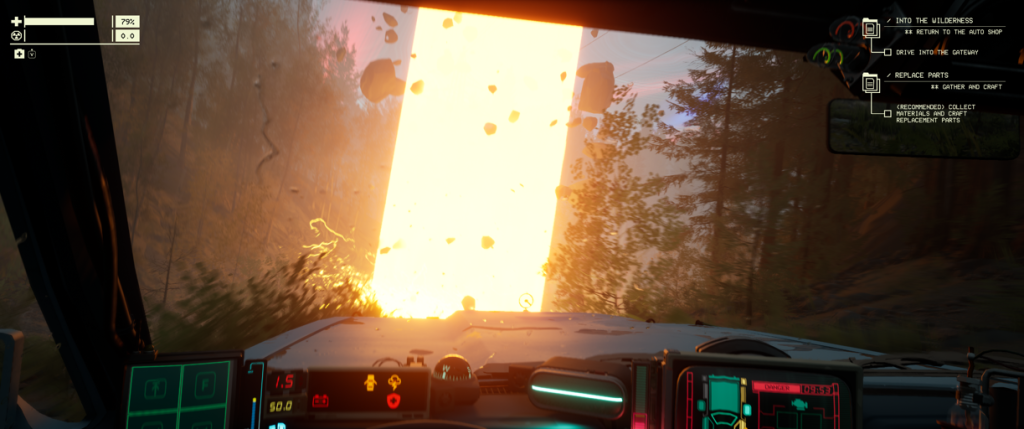
It was up to me to drive fast and try to dodge the ever growing anomalies that littered my path. The Arc Device created a giant pillar of light that served as my portal out of there, but it also triggered an instability storm. It’s a concept all too familiar to Battle Royal and Extraction shooter players.
I could see the ring closing in on me as I floored it to the pillar of light. Things were banging my car around pretty hard and I basically limped into the pillar of light. It warped me back outside the safety of the Pacific Drive garage.
The relief of returning mostly safely was a nice rush. I also looked forward to using the loot I definitely earned for that trip. As soon as I exited the car, I could see all the damage and the reason I limped along at the very end: a tire fell completely off.
I still remember that first run and how much I looked forward to the next one. Fast forward to now and I’ve logged multiple trips successful trips with 2 failures mixed in and vastly upgraded my car. There’s too much to talk about now, so until next time, just buy Pacific Drive.
